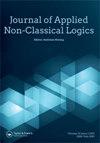可数集合的最交点
Q1 Arts and Humanities
引用次数: 0
摘要
我们通过可数集合的自然密度,在逻辑量词“most”的基础上引入了一种新的集交算子,称为“most-intersection”,用于确定给定可数(可能无限)系统集合的多数特征。new运算符根据自然密度确定给定集合中“大多数”集合中的元素。这个概念允许人们定义一个具有最小信息损失的无限/有限集合的多数集成员特征,与标准交集算子相比,当用于统计集成时。给出了多交算子在形式语言理论和超图中的一些应用。最相交算子的引入导致了在纯数学和应用数学中的大量应用,其中一些我们留下了进一步研究的空间。本文章由计算机程序翻译,如有差异,请以英文原文为准。
Most-intersection of countable sets
We introduce a novel set-intersection operator called ‘most-intersection’ based on the logical quantifier ‘most’, via natural density of countable sets, to be used in determining the majority characteristic of a given countable (possibly infinite) collection of systems. The new operator determines, based on the natural density, the elements which are in ‘most’ sets in a given collection. This notion allows one to define a majority set-membership characteristic of an infinite/finite collection with minimal information loss, compared to the standard intersection operator, when used in statistical ensembles. We also give some applications of the most-intersection operator in formal language theory and hypergraphs. The introduction of the most-intersection operator leads to a large number of applications in pure and applied mathematics some of which we leave open for further study.
求助全文
通过发布文献求助,成功后即可免费获取论文全文。
去求助
来源期刊

Journal of Applied Non-Classical Logics
Arts and Humanities-Philosophy
CiteScore
1.30
自引率
0.00%
发文量
8
 求助内容:
求助内容: 应助结果提醒方式:
应助结果提醒方式:


